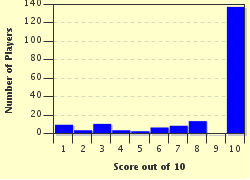Quiz Answer Key and Fun Facts
1. Waterlooville, Farnborough, Fleet, Eastleigh
2. Lowestoft, Bury St. Edmunds, Haverhill, Felixstowe
3. Jarrow, Whitley Bay, Washington, Gateshead
4. Leominster, Ross-on-Wye, Kington, Ledbury
5. Long Eaton, Bolsover, Swadlincote, Glossop
6. Royal Wootton Bassett, Marlborough, Melksham, Devizes
7. Fleetwood, Clitheroe, Darwen, Chorley
8. Cleethorpes, Scunthorpe, Spalding, Gainsborough
9. Stroud, Stow-on-the-Wold, Cinderford, Wotton-under-Edge
10. Marlow, Gerrards Cross, Princes Risborough, Aylesbury
Source: Author
EnglishJedi
This quiz was reviewed by FunTrivia editor
Pagiedamon before going online.
Any errors found in FunTrivia content are routinely corrected through our feedback system.

